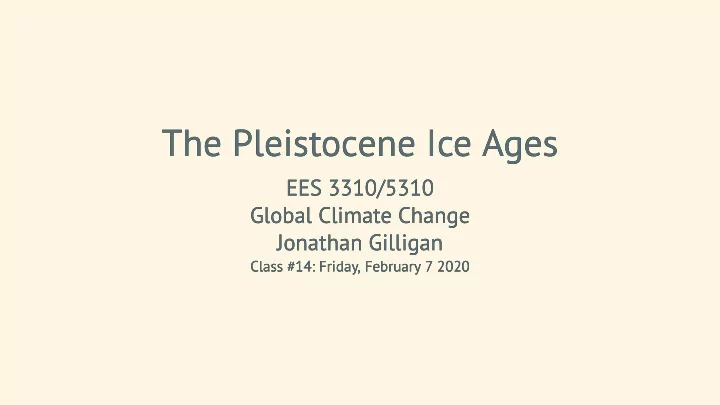

The Pleistocene Ice Ages The Pleistocene Ice Ages EES 3310/5310 EES 3310/5310 Global Climate Change Global Climate Change Jonathan Gilligan Jonathan Gilligan Class #14: Class #14: Friday, February 7 Friday, February 7 2020 2020
Oxygen & Hydrogen Isotopes Oxygen & Hydrogen Isotopes
Oxygen & Hydrogen Isotopes Oxygen & Hydrogen Isotopes 18 18 O O ⎛ ( ) − ( ) ⎞ 16 16 × 1000 ‰ O O sample ref 18 ⎜ ⎟ δ = O ⎜ ⎟ 18 O ( ) ⎝ ⎠ 16 O ref Lighter isotopes ( 1 H and 16 O) evaporate faster Vapor has less of heavier isotopes (lower , ) 18 δ O δ D Ocean is richer in heavier isotopes (higher , ) 18 δ O δ D Warmer greater , in vapor 18 → δ O δ D
Rain, Snow, Ice Rain, Snow, Ice
Rain, Snow, Ice Rain, Snow, Ice Rain, snow are richer in heavier isotopes More precipitation → less deuterium and left in vapor 18 O Farther from source region → smaller and . 18 δ D δ O Reduction in and depends on air 18 δ D δ O temperature. Different for H and O. Comparing and can tell us about 18 δ D δ O both sea-surface temperature and air temperature over glaciers. Higher air temperature over glacier → higher and in glacier snow/ice. 18 δ D δ O
Sediments and History Sediments and History
Bottom top = oldest youngest → →
Solving the Ice-Age Puzzle Solving the Ice-Age Puzzle
Deep-Sea Sediments Deep-Sea Sediments
Past Sea Levels Past Sea Levels Water vapor, rain, snow is always isotopically lighter than sea water Snow, ice on land remove light isotopes from ocean Bigger glaciers: Lower sea-level Greater (positive) in ocean sediments 18 δ O Smaller glaciers: Higher sea-level Smaller in ocean sediments 18 δ O
Sediment Climate Record Sediment Climate Record
Florida Through History Florida Through History
Florida 10,000 years ago Florida 10,000 years ago End of last ice age: End of last ice age: Sea level 400 feet lower Sea level 400 feet lower
Florida 5 million years ago Florida 5 million years ago Last time CO Last time CO 2 was at today’s levels. was at today’s levels. Sea level ~20 meters higher Sea level ~20 meters higher
Florida 50 million years ago Florida 50 million years ago CO CO 2 levels we might reach around 2100. levels we might reach around 2100. Sea level >70 meters higher Sea level >70 meters higher
Summary of Past Sea Levels Summary of Past Sea Levels
Other Evidence Other Evidence of Past Climates … of Past Climates …
Other Evidence of Past Climates … Other Evidence of Past Climates … Sediments tell us about history: Bottom top = oldest youngest → → White carbonate sediments Red clay layer: ~55 million years ago Almost no carbonates What does red layer tell us?
Other Evidence of Past Climates… Other Evidence of Past Climates… Ca 2+ CO 2 − CaCO 3 ⇌ + 3 Alkaline Ocean: High : Reaction runs CO 2 − ⇐ Carbonates survive on sea floor 3 Acid Ocean: Low : Reaction runs CO 2 − ⇒ 3 Carbonates dissolve Only clay is left Red clay layer ocean acidification ⇒ Large burst of into atmosphere. CO 2
Other Evidence of Past Climates… Other Evidence of Past Climates… Ca 2+ CO 2 − CaCO 3 ⇌ + 3 Just below red clay layer, 13 δ C drops suddenly. What does that tell us? Lower means rise in came 13 C CO 2 from organic source.
Paleocene-Eocene Thermal Maximum Paleocene-Eocene Thermal Maximum 55 million years ago 1500–4500 GT carbon added to atmosphere in 1000 years Compare: 600 GT in atmosphere in 1700s, 760 GT today Known fossil fuels: ~5000 GT Temperature rose 5–9°C (9–16°F) Lasted ~120,000 years Transition to cooler temperatures took ~40,000 years Eocene Pliocene Pleistocene → ⋯ → → Gradual cooling for 50 million years Permanent ice on Antarctica ~35 MYA Permanent ice on Greenland, Alaska ~5 MYA Ice age glaciation of North America, Europe begins ~2.8 MYA
Summary of Oxygen Isotopes Summary of Oxygen Isotopes Two different uses: in glacial ice tells us about air temperature near glacier 18 δ O is always negative, 18 δ O but it can be more negative (lower) or less negative (higher). Higher (less negative) means warmer temperature. 18 δ O in skeletons of deep-sea organisms tells us about sea level 18 δ O is always positive. 18 δ O Greater (more positive) means lower sea-level. 18 δ O Changes in ocean are generally opposite to changes in glacial ice 18 δ O . 18 δ O Growth of glaciers: Transfers more light isotopes from ocean to ice. More heavy isotopes left behind in oceans.
Recommend
More recommend